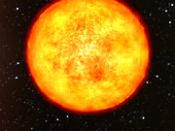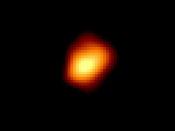Red Giant Stars
Red Giants are very large, cool and luminous stars. This stage lasts about 10% of the stars life. They are old stars meaning they don't have much lifetime left.
Red giant phase occurs in stars, which weigh less than 4 solar masses. The star starts to collapse towards the centre causing the star to heat up. The fusion rate increases within the outer shells; this causes the star to expand. The surface cools, making the star turn red. The red colour increases causing the star to expand increasingly.
Red giants occur as a result of the hydrogen in the core running out. This means that the hydrogen burning can only continue in the outer shells around the helium core. The core contracts under gravity until the temperature becomes high enough for helium to fuse to carbon and oxygen.
Helium 'burning' last around 10 million years. When the helium runs out it continues burning in the outer shells.
The star heats up causing carbon to turn to neon to sodium and then to magnesium. This lasts about 10 thousand years. Contraction and shell burning continues. Neon to oxygen and magnesium lasts 12 years. Oxygen to silicon and sulphur lasts 4 years, and silicon to iron takes 1 week.
Some of the fusion reactions can be written as:
41H 2He + 2e+ + 2v + Energy
4He + 4He 7Be + Energy
7Be + 4He 12C + Energy
The energy in these equations can be worked out using: ?E = ?M x C"
Element madeMass before/uMass after/uDifference/uDifference(?M)/kgc"?energy
He4.03164.0036910.0279094.6608E-299E+164.19472E-12
Be8.00527.0169280.9882721.65041E-279E+161.48537E-10
C11.01952812.011-0.991472-1.65576E-279E+16-1.49018E-10
As a red giant star the sun will lose a lot of mass due to weak gravity at the edge. The core heats up to 108K where triple-? process begins, which is the fusion of helium. The outer shells...



Report of red giants
I think this was very educational essay and very well written, has educated me on this subject
4 out of 6 people found this comment useful.